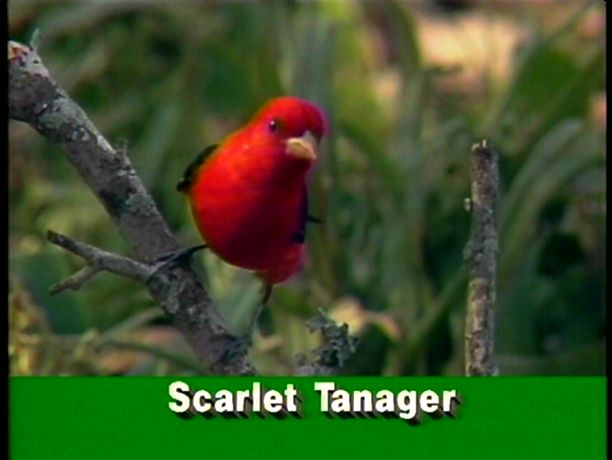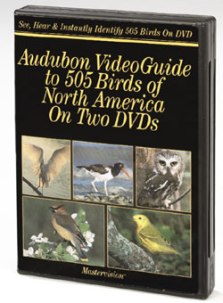Reviewed by Grant McCreary on March 1st, 2007.
Printed field guides can come in many different formats, but due to the inherent limitation of the medium they are all static. They cannot be dynamic – they cannot show a bird in motion. The National Audubon Society changed this in the 1980’s with the release of their video guide. It was originally released on five VHS cassettes, but has now been converted to DVD (two discs which are available either separately or as a set). Will this guide replace your favorite printed field guide? Definitely not. Is it still useful as a supplementary guide? Well…maybe.
This guide covers 505 species that regularly occur in the United States and Canada. The first disc includes 247 species (all the non-passerines except for doves, cuckoos, nightjars, hummingbirds, swifts, trogons, and woodpeckers), and the second 258 (all the passerines as well as the non-passerines previously mentioned). The taxonomy has not been updated from the original release and is thus very out-of-date. For example, you will find many species names here that you will not see in current field guides, such as Oldsquaw, Olivaceous Cormorant, and Gray-breasted Jay. Additionally, this guide was released before the splitting of the Sage Grouse, Scrub Jay, Solitary Vireo complex, Rufous-sided and Brown Towhees, and Rosy Finch, among others. This could be very confusing to those who started birding after these changes were made (however, the taxonomy has been updated in the mini field guide, see details below). The species selection is generally good, but there are some disappointing absences. The majority of the empid flycatchers are missing (it contains only Least, Acadian, and Pacific-slope and Cordilleran combined together as “Western”), and birders need all the help they can get with that group! Additionally, the Oporornis warblers are represented solely by the Kentucky Warbler, omitting Connecticut, Mourning, and MacGillivray’s. It would be nice to have some video to compare these hard-to-find, skulking birds. But of course the fact that they are hard to find, much less get adequate video of, can explain the lack of video footage. But they still could have been presented with photos only.
The species accounts average 30-40 seconds each, and consist of narration, video and/or photographs, a range map, and playback of songs and calls. A narrator gives pertinent information on the identification, behavior, and range of the species. The birds are shown in a video clip and/or still photos. A number of species are only shown using static photographs, unfortunately. For some sexually dimorphic species one is shown in a video (usually the flashier male, such as this Black-throated Blue Warbler), while the other is illustrated with a photo only. The lack of video for some species is disappointing, especially for a few in particular such as the Sage Grouse.

Over all I would rate both the video and photos as disappointing. The photos are not as good for identification as those found in Kaufman’s field guide, although they do adequately give an idea of what the species looks like. The appeal of video is that it can give an impression of both how a bird looks and how it behaves. Some of the videos here accomplish this, but others do not. The problems include the video being too shaky, dark, and the bird too small in the frame. Some of them are just ok, like the Painted Redstart. The video of this bird shows it flitting around with its tail and wings spread out characteristically. This gives the viewer a good idea of what to look for. However, you do not get a sense of just how startlingly gorgeous this bird is in real life. But then there are those that work very well, such as the female Hooded Warbler and the Ovenbird. Both are shown well enough to see what the bird actually looks like. And they are both shown engaging in characteristic behavior – the Hooded is flashing the white in its tail and the Ovenbird is walking on the ground.
The range maps show permanent, summer, and winter ranges (example). They are useful only as a general idea of the species’ range. The lack of intra-country political boundaries (US states and Canadian territories) limit their usefulness. Range maps from any of the major North American field guides are preferable.
The song and calls of the species are often played during the species account. Be aware that some tracks also include other species in the background, which can possibly cause confusion. There is also narration over the sounds. Thus the sounds included can be helpful, but they will not take the place of separate CD’s.
In addition to the species accounts there is also a brief introduction (01:58) that includes a few comments from Roger Tory Peterson. An identification glossary (01:05) uses photos to illustrate some commonly used body part names such as speculum and nape. These features are included on both discs.
The two disc set also includes a “mini field guide” booklet which includes all 505 species. I do not know if one is included with the individual volumes. The taxonomy has thankfully been updated (in my copy it says it is current as of July, 2004). Name changes and splits are indicated, for example “Mexican Jay (Gray-breasted Jay)” and “California Towhee, Canyon Towhee (formerly Brown)”. This is very welcome, and should help eliminate any confusion caused by the discs (for those who actually check out this booklet, anyway). Most of the species include a single, small photograph. The majority of these are at least adequate, and some are quite good. The rest are fuzzy and indistinct and of limited usefulness. There is at least one mistake here – the photo of the supposed White-eyed Vireo is actually that of one of the vireos in the Solitary complex (most likely it is a Blue-headed Vireo). A very brief description of the bird’s range, habits, and field marks is also given. Overall the booklet is a welcome addition, especially for the updated taxonomy and its use as an index for the contents of the DVD’s.
The DVD mastering was fairly well done, especially given that the contents were originally produced for VHS. The picture quality is fine; any problems are due to the source material. The menus are not very pretty, but they are functional and for the most part intuitive (a few examples: 1, 2, 3). The only issue I have with them is the labels used for some groups. Groups such as hawks and shorebirds that have multiple sub-categories have some weird organization and labeling. The shorebirds, for example, full under the sub-categories “Shorebirds” and “Sandpipers”. “Shorebirds” contains just the plovers, while “Sandpipers” has everything else including oystercatchers, stilts, avocets, and phalaropes. Also, why is the Great Blue Heron the only bird under “Wading Birds” while the rest of the herons and egrets are found under “Egrets”?
Before the internet age these discs would have been a must-buy due to the lack of alternative access to video footage of birds. But now you can find just about anything online. The Birds of North America Online includes video for an increasing number of species (although it does cost $40 annually). There is also the Internet Bird Collection, sponsored by the publishers of the Handbook of the Birds of the World series. The site currently has video material for 35% of the world’s bird species. I have not had time to explore this site properly, but it looks to be an extremely valuable resource (and it is free!).
This set may still be the most comprehensive video collection of North American birds (at least I’m not aware of anything that rivals it). However, the high price and photographic quality issues make it difficult to recommend.
Disclosure: I get a small commission for purchases made through links in this post.



Comment